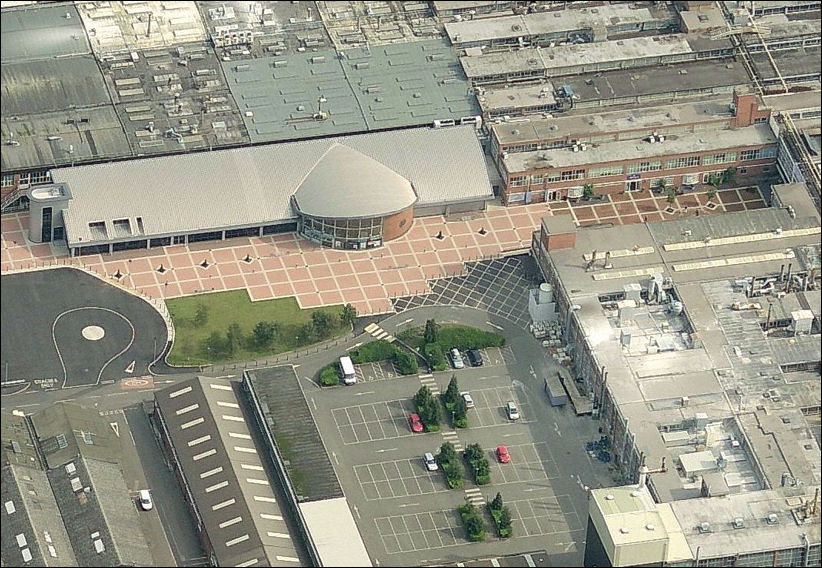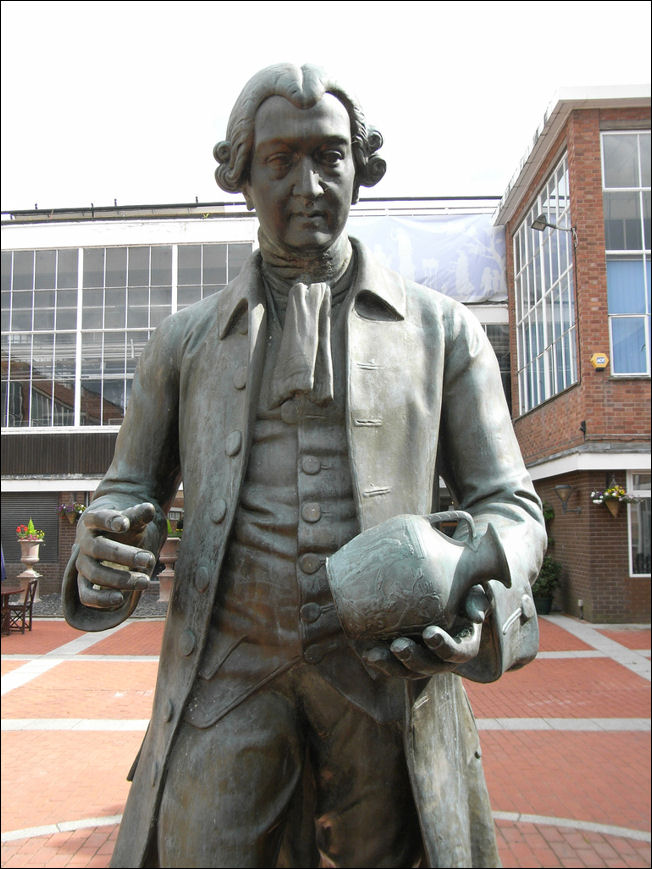|
Inscription:
Alongside the statue is a notice which reads:
JOSIAH WEDGWOOD
(1730-1795)
This replica statue was cast in the 1950s and depicts
the founder of Wedgwood, Josiah Wedgwood I, holding
his most famed production, the Portland Vase.
The first statue was sculpted by Edward Davies and
cast in bronze in 1860. In 1862 it was displayed at the
International Exhibition where it was seen by over six
million visitors. On 24th February 1863 it was erected
outside Stoke-on-Trent Railway station where it still
resides today welcoming visitors to the city.
|
Description:
Wedgwood is
depicted wearing the formal dress of the period, including
frock coat, buckled shoes, stockings, knee breeches and wig.
In his left hand, he holds a copy of the Portland Vase, a
Roman artefact in glass, of which his Burslem Manufactory
made 50 reproductions in 1790. |
|
Background to the sculpture:
In the mid 1950's
an employee of Stoke on Trent Council noticed the plaster
statue used for the original casting of the figure of Josiah
Wedgwood outside Stoke on Trent Railway Station (installed
1863) in a storage depot. He mentioned this to his wife, Mrs
Elsie Daley, who was an employee of the Wedgwood factory in Barlaston, and she in turn placed a note in the firm's
suggestion box proposing that the statue be rescued and
sited somewhere near the Barlaston factory site.
After
extensive repairs by Wedgwood's chief modeller, Eric Owen,
including the replacement of missing fingers, a broken arm
and leg, and a damaged skirt to the jacket, the application
of aluminium paint and coloured pigments, the pseudo-bronze
was erected outside the factory offices in 1956. The
Directors then decided on a more durable replacement which
led to the plaster statue being sent to the Corinthian
Bronze Company in Peckham within the year. The statue was
recast, again in bronze, and by the autumn of 1957 the new
bronze was in place in front of the Barlaston offices.
Originally the statue faced the building, but was later
turned round to face the Factory Showrooms. In 1999 the
decision was taken to relocate the bronze in the centre of
the new piazza, where Sir Josiah now greets all visitors to
the Wedgwood Story, an interpretive centre set up by the
company. |
|
About the subject:
Josiah Wedgwood I
(1730-1795) was born in Burslem, now one of the six towns of
'the Potteries' or Stoke-on-Trent, Staffordshire.
He belonged to the fourth
generation of a family of potters. After completing an
apprenticeship, he worked in the family business until about
1749 and then in partnership with other potters until the
early 1760s. He set up as an independent potter in 1759,
opening a successful manufactory in Burslem. In 1769 He set
up another one near Hanley, which he called 'Etruria' in the
incorrect belief that Greek vases were Etrusacan in origin.
Etruria, which initially only manufactured his ornamental
vases before his 'useful' ware was transferred there in
1771, included a model factory, workers' village and
mansion.
He was outstanding
throughout his life in his scientific approach to pottery
making and research into materials, marketing, industrial
design, labour relations and welfare. He became
internationally known for his high-quality ceramics,
including creamware and jasperware.
A relief in Stoke Church by
John Flaxman (1755-1826) records that he, 'converted a rude
and inconsiderable Manufactory into an elegant Art and An
important part of the National Commerce'. |
|
![]()
![]()
![]() Index
of all Stoke-on-Trent art |
Index
of all Stoke-on-Trent art |
